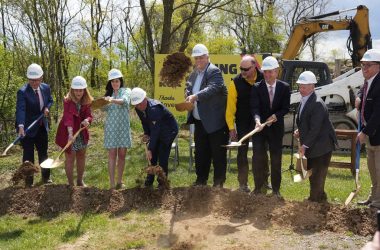By MAX GARLAND
Charleston Gazette-Mail
CHARLESTON, W.Va. — Appalachian Power representatives said the utility’s plans to acquire two wind farms should benefit the company even without factoring in federal environmental regulations, citing tax credits and a reduced reliance on outside energy purchases, according to recent filings with the state Public Service Commission.

(AP file photo)
John Scalzo, Appalachian’s director of regulatory services for West Virginia, said in prepared testimony that Appalachian owning additional wind production would reduce its exposure to volatile energy markets. He added that the revenue requirement for the two wind farms — the Beech Ridge II Wind Facility in Greenbrier County (50 megawatts) and the Hardin Wind Facility in Hardin County, Ohio (175 megawatts) — would drop from $10.2 million in the first year of the farms’ operations to $6.5 million in year 10 because of tax advantages.
“The Wind Facilities will mitigate the effects of any future regulation of carbon,” the filing said. “However, even if there is no carbon regulation over the lives of the Wind Facilities, the Wind Facilities are still expected to produce economic benefits for [Appalachian Power] customers.”
Regulatory concerns are currently affecting natural gas prices, Karl Bletzacker, director of fundamentals analysis for American Electric Power Service Corporation, said in prepared testimony. He cited a forecast that recognized “credible upside threats” to North American natural gas prices, including for its role in electricity generation, and data from oilfield services company Baker Hughes that showed a sharp drop in natural gas- and oil-directed drilling rig counts.
“The potential for increased costs associated with environmental requirements associated with hydraulic fracturing is also a very likely upside threat to natural gas prices,” Bletzacker said.
Even with the touted cost benefits compared to natural gas, customers would still see a construction surcharge or a similar cost recovery method for the wind farms’ development, according to Scalzo. He said any sort of rate increase would be temporary because the costs of the wind facilities are expected “to be more than entirely offset” in the long run because the company would be less reliant on purchases from the regional energy market.
The specific surcharge rates customers would experience are expected to be determined in Appalachian’s 2019 Expanded Net Energy Cost proceeding, which reimburses the company for past and ongoing fuel costs.
“It is just and reasonable for customers to pay for the benefits of the Wind Facilities as they are receiving these benefits,” Scalzo said of the potential surcharge.
The benefits are similar to what Appalachian cited in its purchase agreement with NextEra’s Bluff Point Wind Energy Center in Indiana. Concerns were raised in that case, which the PSC approved in March, that if the wind energy market faltered customers would be locked into higher rates while Appalachian wouldn’t have to take on those costs itself.
Appalachian requires approval from the PSC, along with an OK from both the Virginia State Corporation Commission and the Federal Energy Regulatory Commission, to buy the wind farms. It asked the PSC to issue a final order on the case by March 31, 2018. The facilities are expected to be in commercial operation in 2018, according to the farms’ developer Invenergy’s website. Appalachian would take full ownership of the farms after their construction is completed.
Appalachian had several options outside the two farms to choose from for additional wind power, according to its filing. When it submitted its request for proposal, a method for a utility to ask for additional power generation, 15 entities responded with 31 wind projects that would satisfy the RFP. Twenty-three of those projects fulfilled the RFP’s requirements and were located among six different states: West Virginia, Virginia, Maryland, Pennsylvania, Ohio and Indiana.
Scalzo said some of the bids were nearly identical to Beech Ridge II and Hardin before deciding to go with those two facilities. Beech Ridge II “was determined to be the least expensive asset” and has the advantage of being next to the Beech Ridge I wind facility, which Appalachian already receives power from via a purchase agreement. The utility chose Hardin because it uses General Electric turbines like both Beech Ridge facilities do, generating operation and maintenance savings.
The Hardin facility has a net present value to customers of $55 million and Beech Ridge II has a net present value to customers of $21.4 million, Scalzo said.
Joseph Karrasch, assets investments manager for American Electric Power Service Corporation, said in prepared testimony that Appalachian went with those projects to take full advantage of the federal production tax credit.
“The main benefit of pursuing the purchase of the Wind Facilities is that they will benefit from 100% of the PTC,” he said. “This federal subsidy, which flows to APCo, helps to buy-down the net costs that [Appalachian and Wheeling Power] customers would pay.”
To receive 100 percent of the production tax credit, wind projects must have begun construction before 2017 and must be completed by the end of 2020, Karrasch said, which the two wind farms are expected to satisfy.
See more from the Charleston Gazette-Mail




